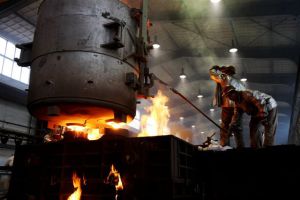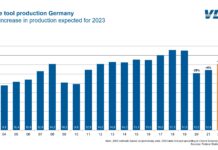 The foundry steel castings mainly manufacturer for energy generating purposes Sande Stahlguss GmbH (SSG) has developed a high alloyed 9% chrome cobalt-boron steel (called CB2, GX13CrMoCoVNbNB9-2-1) which increases the efficiency of power plants and reduces C02-emissions.
The foundry steel castings mainly manufacturer for energy generating purposes Sande Stahlguss GmbH (SSG) has developed a high alloyed 9% chrome cobalt-boron steel (called CB2, GX13CrMoCoVNbNB9-2-1) which increases the efficiency of power plants and reduces C02-emissions.
Several industrialised countries including China have committed to reduce CO2-emissions. In global average coal fired power plants have an efficiency of approximately 44%. The major part of energy input remains unused. One option to enhance the efficiency is to make use of the combined cycle cogeneration plants (CCCP). The efficiency level can be raised up to 50% (see pic. 1) or even higher.
Notwithstanding the design optimisation of combined cycles the efficiency of power plants can be enhanced by raising the operating temperature. The goal is to minimise the loss of heat and to operate turbines at higher temperatures and pressures. A proven side effect of enhancing efficiency by raising operating temperatures is the reduction of carbon dioxide emissions.
Conventional steels for energy purposes have to withstand a temperature of 560°C (1040°F) and a pressure of 250 bar (3600 psi) in long-term operation. High alloyed 9% chrome steel, such as P91, are applied wherever the material has to withstand up to 600°C (1112°F) and 270 bar (3900 psi). The net-efficiency of power plants using P91-steel is roughly 45.3% (see pic. 2 [5]). By using the newly developed CB2-steel the operating temperature can be raised up to 620°C (1150°F) and the efficiency output would meanwhile rise by nearly one percent point up to 46%. Enhancing the efficiency by one percent point implies a reduction of carbon dioxide emissions of 2.4 million metric tons CO2 based on a power plant operation time of 30 years and the use of a 700 MW turbine (see pic. 2 [5]). Moreover, 2.000 t NOx, 200 t SO2, and 500t particulates could be saved (see pic 2).
Several research projects working on the development of new materials focus on long time creep rupture strength at temperatures above 600°C (1112°F). Sande Stahlguss GmbH participates in above research projects for the development and the research on those materials. The German research program for “high temperature steels and materials” is one of these groups developing CB2 steel grade.
Apart from the results of the joint research projects SSG gained results for creep rupture tests for the CB2 steel for varying melt metallurgies (current arc furnace/aod converter) and different quality heat treatments from numerous parts in production. The results for the achieved creep rupture strength lie within or above the fluctuation margin of the samples recorded and forecasted in the joint research groups.
The CB2 steel (GX13CrMoCoVNbNB9-2-1) is a successor of the conventional high temperature steel P91 (G-X12CrMoVNbN9-1), P911, and P92 (G-X12CrMoWVNbN10-1-1) developed in order to allow higher operating temperatures whilst maintaining at least the same mechanical properties. This can be achieved by varying the melt analysis and adding cobalt and Boron to the given alloy.
The advantages of the CB2 steel for applications in highly critical steam conditions are obvious. Several research projects proved that the creep rupture strength of CB2 steel is higher at the same temperature and pressure than conventional high alloyed 9% chrome steel. The operating temperatures can thus be higher without sacrificing the mechanical properties. Moreover, the wall thickness might be reduced in order to save a significant amount of material. A lower wall thickness will also result in a lower thermal stress [3].
Despite the intensive and long research in Europe this new material is hardly used by power plant designers. In fact competitors in China are moving ahead. Sande Stahlguss GmbH has delivered approx. 500 t of steel castings in CB2 steel mainly for Chinese power plants since 2011.
The scope of products ranges from valves to inner casings for highly critical steam conditions at high to ultra high pressure. Due to the extreme loads the valves are exposed to the wall thicknesses of the delivered castings reach 300 mm. The net weight per part ranges from 1.5 to 25 t. Constructions welds (similar or dissimilar) are another scope of supply of CB2 castings from SSG.
The narrow margins for the analysis given by our customers have to be considered and are challenging. The maximum gas contents which have to be met require the use of an AOD (Argon-Oxygen-Decarburisation) refining unit. The investment in the AOD refining, which was done mainly for stainless steel, cold work steel, conventional high temperature steels, and duplex steels, proved to be the right decision. For stainless steel and cold work steels with a low carbon content a sufficient decarburisation is compulsory. The higher degree of purity affects the mechanical properties positively. The secondary production (repair welding) benefits from the significantly lower amount of defects. The extensive experience made with conventional high temperature and high alloyed steel grades is helping SSG now, especially for the quality Heat treatment of CB2 steel. Due to the lessons learned a decisive quality Heat treatment for CB2 steel was developed, in order to meet the high customer requirements safely.
From a manufacturing perspective, the CB2 steel is even more difficult to handle than conventional high temperature steel grades. SSG has gathered experience in the casting technology as well as welding technology for CB2 steel since 2011. The experience that is now available at SSG encompasses fabrication welding as well as construction welding. For further improvements SSG is testing recently developed CB2 steel grade wire for gas metal arc welding (GMAW) in the production environment.
Due to the experience of more than 500 t up to date delivery weight of CB2 steel castings made throughout the whole production process the lead times could be reduced significantly. Besides the extraordinary high quality standard, the short lead time is another reason why customers placed further orders of approximately 400 t delivery weight in CB2 steel at Sande Stahlguss GmbH.
The use of high alloyed CB2 steel in modern power plant technology allows higher operating temperatures compared to conventional steel grades. By using those steel grades the efficiency of the existing plants can be enhanced and the carbon dioxide emissions can be reduced significantly. Sande Stahlguss GmbH is actively working on the research for new steel grades and is a reliable partner in the development of new materials. Doing this, Sande Stahlguss GmbH contributes its share to the reduction of carbon dioxide emissions.



